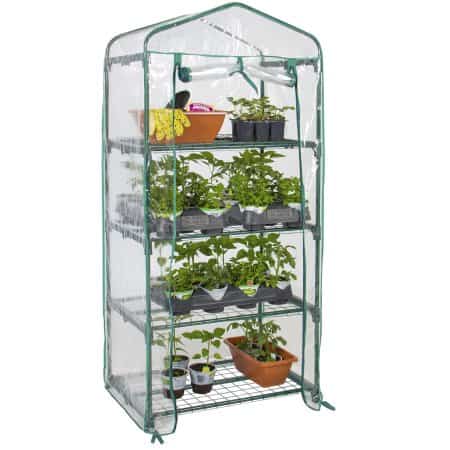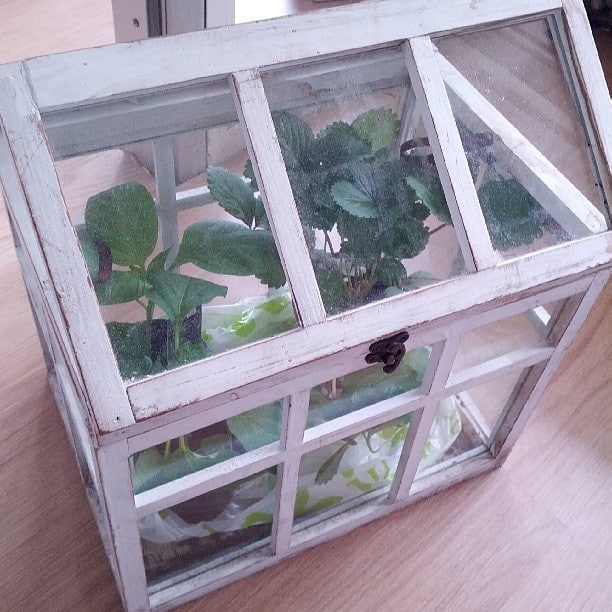Did you know that a small indoor greenhouse can give you food and produce for years to come?
Think of all the herbs, veggies and flowers you can grow in this carefully managed system; you’ll be surprised at how much a small indoor greenhouse can do to extend plant life!
You don’t need a huge expensive greenhouse to be able to enjoy indoor growing.
If you know what to expect from growing in small spaces, you’ll be able to maximize your yields and get seedlings off to a great start.
You’ll also be able to anticipate issues before they become big problems.
If you’re interested in growing plants in small indoor greenhouses, you’ll need to know what to grow, how to grow it and what challenges you might face before you buy.
10 tips to maximize space in a small indoor greenhouse
Read about the varieties of plants and tips and tricks to growing produce in mini indoor greenhouses in our article here.
Here are our top tips to maximize space when having small indoor greenhouses:
Decide your greenhouse size
An indoor greenhouse doesn’t need to be huge, but you’ll need to make sure it has enough space to accommodate the plants you want to grow along with any other gardening equipment.
Generally, you’ll need a greenhouse that will have enough room for some shelving and benches as well.
Shelving provides more space by giving you extra surfaces for growing plants, small seedling pots, seed starter trays and other essential equipment.
You’ll need to have a few feet of space on each side for easy access and maintenance too.

Zoning your greenhouse
Having an overview of the different sections your greenhouse will give you better ideas to maximize space.
Every greenhouse should have specific areas for the following
- Edible plants
- Non-edible plants
- Early harvest and late harvest plants
- Greenhouse tools, fertilizers and sprays
- Waste disposal
- Water source
Creating separate zones like these will improve your plant’s health by keeping insects and diseases at bay.
Decide which plants to grow in your small indoor greenhouse
Next, decide which plants you’ll be growing and how many you plan to grow.
This is extremely important when deciding what height and width you need for your greenhouse.
- If you’re growing a few herbs or potted plants, you can get away with a very compact greenhouse.
- If you’re growing greens, you’ll need more surface area for planting and growth.
- When growing taller plants like tomatoes, you’ll need to ensure that they have plenty of room to reach their full height.
- Plants with a climbing growth habit or those that require tall stakes, will need a taller greenhouse as well.
When arranging plants, note that each plant should ideally have proper drainage and lighting.
They should not crowd each other nor block the sun. Certain leafy vegetables can spread out quickly.
You can place plants that require less light (like kale) under these veggies.
Plants that prefer dark places can be kept under shelves or at the bottom of the greenhouse on the floor.
You can also install shade cloths to block excess light.
Plant rotation in your greenhouse
Know your plant’s life cycle well.
If a certain plant has a short life span, you can plan for another plant in its place a few weeks in advance.
The soil used by the other plant can be reused.
Hence, you save space by avoiding unnecessary planting.
Knowing the crop cycle and harvesting period can help you plan which plants to grow during different times of the year in the same spot.
Use indoor greenhouse open spaces wisely
Greenhouses have a lot of hidden and not-so-obvious spaces that can be used well for plants.
Consider the ceiling
Can you install rods or frames to hang plants?
You can arrange for wires hanging from different ends of the greenhouse and clip together seed packets and washcloths with large pegs.
You can also plan for artificial lighting like fluorescent LEDs to hang from ceilings so that they don’t in anyway take up extra space.
Look at the bottom area
Are there places where you can keep small greenhouse materials?
Also, look at the back of your greenhouse door.
Can you hang items over there to maximize that space?
Use the side spaces as well.
A rich green wall full of vines and creepers is not just aesthetically soothing, its also a great way to maximize space in a small indoor greenhouse.
Shelving and arrangement
Multi-level shelving can also maximize space in indoor greenhouses.
If they are removable shelves, its all the better!
If you tend to move your greenhouse around, consider aluminium or light metal shelves.
As these are not heavy, you can rearrange them easily.
Sometimes, it can even make more sense to install vertical cabinets instead of horizontal ones and vice versa.
Experiment with your storage design to make best use of open spaces.
Arrange work benches in a way that you can place pots under them or hang things by their side.
One thing to note when installing shelving is that all plants should be at a reachable distance.
Shelves should not be too high or way at the back of the greenhouse, blocked by benches, in a way that you will not be able to observe your plants.
Quick tip: Did you know you can re-purpose old ladders as shelves for pots?
Let it rest on one side quietly and you won’t even know it’s there!
Wall hooks and hangers
These days, many hardware stores have hooks and hoops that you can stick on walls
Use them to hang equipment, spray bottles and gloves.
Even hanging organizers can use up empty spaces like ceilings and doorways.
They are available in numerous sizes with pockets that can be closed and are pretty sturdy.
You can also use wooden pallets to hang tools.
All you need to do is screw it into your wall.
Using rolling carts
Rolling carts are a great addition to small indoor greenhouses as they provide space to keep the plants along with the versatility of movement.
You can move them in and out as you like if the space inside your mini greenhouse gets too crowded.
You can also change their location easily during different seasons so that the plants in them get maximum light, heat and attention.
Rolling carts are inexpensive too!
Quick tip: You can also consider using old toys with wheels too for planting veggies!
This helps to recycle them and makes your efforts more sustainable for the environment.
Buy a small indoor greenhouse kit
If the thought of setting up a greenhouse with so many specifications gets a bit too overwhelming for you, small indoor greenhouse kits are available for help.
These generally include everything you’ll need to set up a greenhouse inside and out.

Frequently declutter your greenhouse
The trick to maintaining the space you created for your greenhouse is to constantly declutter it.
Throw out pots and trays you no longer use.
Check expiry dates of your products and remove them from the shelves if they do not serve any purpose.
Think of tools that serve more than one purpose and use them instead of owning many tools.
Certain tools have features installed on both their ends to maximize use.
Small Indoor Greenhouses
Small greenhouses serve the purpose of saving space and having just a limited set of plants, which in turn helps you to give more attention to the existing plants.
In apartments and small homes where spacing is already a concern, a small indoor greenhouse can be a life saver!
There are many creative ways to boost space inside small greenhouses.
Using open spaces, ceilings and floors are some of the ways to get maximum use of the area.
Installing shelving, portable racks, hanging baskets and wall hooks can also increase the planting area in a tiny greenhouse.
Even recycling ladders, old toys and kitchen cabinets for your greenhouse can save space and money.
Lighting and ventilation are two core areas to be concerned about when setting up indoor greenhouses.
Plants must not overcrowd each other in terms of space, light and resources.
This problem can be mitigated by planning your crops in advance according to their life cycles.
Some of our tips can help you create more sustainable space in your greenhouse.
Mini Garden on the Balcony – Fresh Vegetables Every Day
80 Acres Farms Automated Indoor Farm of the Future
Small Greenhouse ~ Find the Best for Your Gardening
